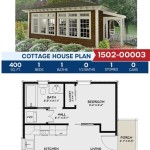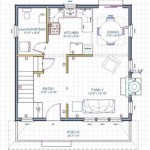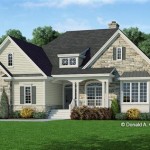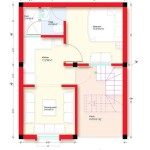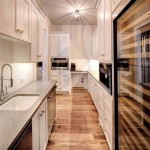Frank Lloyd Wright Home Design Plans: An Exploration of Organic Architecture
Frank Lloyd Wright, a towering figure in 20th-century architecture, left an indelible mark on residential design. His philosophy of "organic architecture," emphasizing harmony between human habitation and the natural world, continues to inspire and influence architectural design to this day. Understanding Wright's principles and how they translate into actual home design plans provides valuable insight for architects, homeowners, and anyone interested in the evolution of modern living spaces.
Wright's designs were not merely about aesthetics; they were driven by a desire to create homes that enhanced the lives of their inhabitants. He believed that a building should grow from its site, respecting the surrounding landscape and reflecting the inherent properties of the materials used. This approach led to the development of distinctive architectural elements and spatial arrangements that characterize his signature style. Examining Frank Lloyd Wright home design plans reveals a consistent application of these principles, adapted to the specific needs and contexts of each project.
Many sources offer examples of Frank Lloyd Wright's plans. One source is The Frank Lloyd Wright Foundation, which seeks to preserve Wright's work. Another source is the Avery Architectural & Fine Arts Library at Columbia University, which maintains collections that may include Wright's original drawings and related documents. Finally, the Library of Congress may include documentation related to Wright's work as part of its broader collection of architectural records.
Key Principle 1: Organic Architecture and Site Integration
The cornerstone of Frank Lloyd Wright's architectural philosophy was organic architecture. This concept dictated that a building should be intrinsically linked to its environment, appearing to grow naturally from the ground. This integration extended beyond mere visual harmony; it influenced the building's form, materials, and orientation. Homes designed according to this principle were often characterized by long, horizontal lines that echoed the landscape, low-pitched roofs that blended seamlessly with the horizon, and extensive use of natural materials such as wood, stone, and brick.
Examining Frank Lloyd Wright home design plans reveals a meticulous attention to site analysis. Before even putting pencil to paper, Wright studied the land's topography, vegetation, and climate. He sought to capitalize on the site's natural advantages, such as sunlight and prevailing winds, while mitigating its potential drawbacks, such as excessive exposure or drainage problems. This approach ensured that the home was not just placed on the land, but rather integrated into it. For instance, the placement of windows was carefully considered to maximize natural light and offer framed views of the surrounding landscape.
The use of local materials was another key aspect of Wright's commitment to organic architecture. By utilizing materials that were readily available in the region, he reduced transportation costs and minimized the environmental impact of construction. Moreover, the use of indigenous materials helped to ground the home in its specific location, creating a sense of belonging and connection to the land. He would often leave these materials in their natural state, celebrating their inherent beauty and texture rather than concealing them behind artificial finishes.
Specific examples of this principle in practice include Fallingwater, where the home is literally built over a waterfall, and Taliesin West, Wright's winter home and architectural school in Arizona, which is constructed from desert stone and integrates seamlessly into the harsh landscape. These iconic structures demonstrate Wright's ability to create buildings that are not just visually appealing but also deeply connected to their natural surroundings.
Key Principle 2: Open Floor Plans and Spatial Flow
Frank Lloyd Wright was a pioneer in the development of the open floor plan, a design concept that revolutionized residential architecture. Departing from the traditional compartmentalized layouts of the past, Wright envisioned homes with interconnected living spaces that promoted a sense of freedom and flow. He believed that open floor plans enhanced family interaction and created a more dynamic and engaging living environment. This concept is evident in many Frank Lloyd Wright home design plans.
The open floor plan was not simply about removing walls; it was about carefully orchestrating the relationship between different spaces. Wright used a variety of techniques to define zones within the open plan, such as changes in floor level, variations in ceiling height, and the strategic placement of furniture and built-in elements. These subtle cues helped to create a sense of order and organization while maintaining the overall feeling of spaciousness and connectivity. The hearth, often a prominent feature in Wright's homes, served as a focal point and a natural gathering place within the open living area.
Another important aspect of Wright's spatial design was the emphasis on natural light. Large windows, skylights, and clerestories were strategically placed to flood the interior with sunlight, creating a warm and inviting atmosphere. The interplay of light and shadow was carefully considered, adding depth and dimension to the spaces. He also utilized natural materials like wood and stone on interior surfaces to reflect and diffuse light, further enhancing the ambiance of the home. These elements all have impacts on the flow of the floor plan.
The Robie House, a quintessential example of Wright's Prairie School architecture, showcases the open floor plan at its finest. The living and dining areas flow seamlessly together, creating a grand and inviting space for entertaining and family life. The use of ribbon windows along the exterior walls further enhances the sense of openness and connection to the surrounding landscape. The gradual transition from public to private spaces, a hallmark of Wright's designs, is also evident in the Robie House's layout.
Key Principle 3: Emphasis on Craftsmanship and Built-in Features
Frank Lloyd Wright was a staunch advocate for craftsmanship and believed that every detail of a home should be carefully considered and executed. He often collaborated closely with skilled artisans and craftsmen to create custom-designed furniture, lighting fixtures, and decorative elements that complemented the overall architectural design. This emphasis on craftsmanship added a layer of richness and individuality to his homes, transforming them into works of art.
Built-in features were another hallmark of Wright's designs. He believed that built-in furniture and storage solutions were more efficient and aesthetically pleasing than freestanding pieces. These custom-designed elements were seamlessly integrated into the architecture, creating a sense of unity and cohesion. Built-in shelving, seating, and storage units not only maximized space but also contributed to the overall aesthetic of the home. Fireplaces were frequently integrated into the built in space.
Wright also paid meticulous attention to the selection and use of materials. He favored natural materials such as wood, stone, and brick, and he often left them exposed to showcase their inherent beauty and texture. He also incorporated decorative elements such as stained glass windows, art glass panels, and custom-designed hardware that added a touch of elegance and sophistication to his homes. These details were not merely decorative; they were integral to the overall design concept and contributed to the unique character of each home.
The Darwin D. Martin House in Buffalo, New York, is a prime example of Wright's commitment to craftsmanship and built-in features. The house is filled with custom-designed furniture, lighting fixtures, and art glass panels, all of which were meticulously crafted to complement the architectural design. The built-in shelving, seating, and storage units maximize space and create a sense of order and organization. The Darwin D. Martin House demonstrates Wright's ability to create homes that are not only functional but also beautiful and inspiring.
Ultimately, Frank Lloyd Wright home design plans represent a holistic approach to architecture, where the building is conceived as an integrated whole that is intimately connected to its environment and its inhabitants. By understanding the principles that guided Wright's designs, one can gain a deeper appreciation for his genius and the enduring legacy of his work. The principles described above showcase Wright's architectural approach.

Frank Lloyd Wright Homes Design Usonian

16 Frank Lloyd Wright House Plans Ideas In 2024

Frank Lloyd Wright Home Plans Homes

Frank Lloyd Wright Inspired Home Plan 85003ms Architectural Designs House Plans

Frank Lloyd Wright Inspiration 20092ga Architectural Designs House Plans

Home And Studio Planta Primera Frank Lloyd Wright Homes Design Architecture

Frank Lloyd Wright S Plan For His House And Studio In 1889 Oak Park Loyd Houses Homes

Frank Lloyd Wright Inspired Home Plan 85003ms Architectural Designs House Plans

S First Frank Lloyd Wright House Blocked By Planning Inspector Archdaily

Frank Lloyd Wright S Usonian Homes N Design Review



